THE MATSÉS & THEIR NEIGHBORS
Compared to the Kayabi, far less has been written about the culture and tattooing customs of the Panoan-speaking Matsés and Matis people of the Javari River valley, an isolated region that cuts an international border between Peru and Brazil. Until recently, both groups were collectively called "Mayoruna," a Quechua word meaning "water people," that was perhaps related to their custom of locating traditional settlements near rivers.
By most accounts, these tribes made "first contact" with the outside world around 1970, but pictorial evidence resulting from the Spix and Martius expedition to the region around 1820 indicates that the Matis may have been "discovered" much earlier. Moreover, many Matsés have recorded through their oral traditions that they were forced by rubber tappers around 1900 to work for them as slave laborers. One of these rubber merchants was the infamous Peruvian politician Julio C. Arana whose notorious company tortured and murdered many other indigenous peoples in the Amazon for profit.
As a result of these lethal conflicts, the Matsés population declined to its lowest point around 1920. Subsequently, they learned to deal with outsiders in two ways: either killing them or adopting individuals into the tribe which is a common practice amongst all Panoan groups. In fact, a very high percentage of Matsés today are actually from other tribes or even non-indigenous communities; these individuals were kidnapped from Brazilian and especially Peruvian frontier towns. Many of these abductions took place during a fifty-year period of warfare with mestizos and other tribes - like the Marubo - who were encroaching upon their traditional lands from the 1920s onwards. |
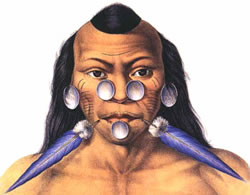 |
Matis warrior, ca. 1820 |
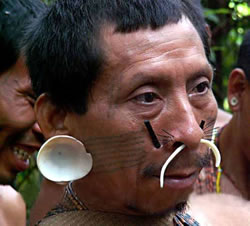 |
A Matis shaman named Biña Chapu Chunu, 2007. Photograph © Dan James Pantone/www.MATSES.org |
The practice of abducting blancos outraged the citizens of one Peruvian town Requena, and around 1960 they formed militias to invade Matsés villages. For the most part, these raids were ineffective because the Matsés deserted their settlements before the militias arrived to burn their homes and crops. But in 1964, the hostilities peaked and the U.S. Army's Southern Command sent helicopters from their base in Panama to assist the militias. The Peruvian Air Force also initiated a napalm bombing campaign in an attempt to eliminate the Matsés people altogether. This action forced the Indians to move even deeper into the jungle.
|
|
About this time a Peruvian woman who had been living with the Matsés for several years escaped. She then began working with two female American missionaries from the Summer Institute of Linguistics (SIL) who learned the Matsés language from her. They wanted knowledge of the language because they were preparing to make "first contact" with the combative tribe. In August 1969, contact was made and the Matsés responded peacefully because they were tired of being hunted, harassed, and living hidden lives in the upland rainforest. They wanted to return to their traditional living areas along the rivers and streams, and end the long period of hostilities with the outside world. |
The majority of the Matsés settled near the SILs field station in Peru. But with the formation of semi-permanent settlements, they soon encountered problems with hygiene (e.g., contaminated drinking water) and a scarcity of animals to hunt. Constant exposure to outsiders also resulted in a series of epidemics (e.g., hepatitis and malaria) that continue to effect the tribe.
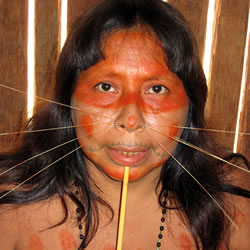 |
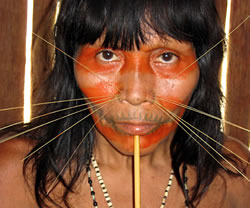 |
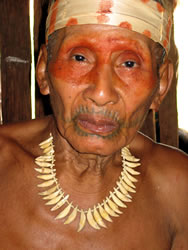 |
Tattoos and labrets of Matsés women.
Photographs © Bjorn Svensson/www.MATSES.org |
Tattooed Matsés man. |
However, the missionaries successfully established a model bilingual education program that currently helps preserve both the Matsés language and culture. This effort has been instrumental in the Matsés' transition into the modern world. But along the way, the Matsés have lost several elements of their traditional culture that at one time established their identity to the outside world. One of these is tattooing.
The Matsés are often referred to as the "jaguar people" due to the characteristic whisker-like labrets and tattoos that they wear on their faces. The Matsés revere the jaguar's strength and hunting prowess, and attempted to harness its power through body modifications they describe as "fearsome." The long stems worn underneath the lips of women have been said to symbolize prey hanging from the jaguar's mouth.
Like the feared Amazon predator, these forms of body modification functioned to make the Matsés appear aggressive and formidable to other tribes in the region. Men also wore a band of teeth-like tattoos across their chests that some writers have misidentified as a form of tally enumerating the number of human victims killed on battlefield. One of my colleagues who works with the Matsés has indicated that this is not the function of the tattoo. Rather these types of tattoos represent "ombo" the Matsés word for "bravery".
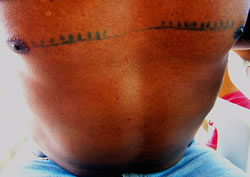 |
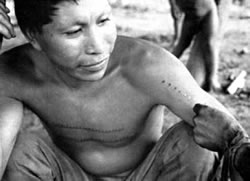 |
Matsés chest tattoos. Black and White Photograph © Steven Romanoff |
Although there are many tattooed Matsés living today and tattoo artists capable of creating the delicate designs, no one has received a traditional tattoo for several decades. Furthermore, little research has been conducted focusing on the cultural practice itself. What has been reported is that in the past tattoo pigments were created from the soot of burnt copal resin mixed with genipap juice and pricked in the skin with a palm tree thorn like other Amazonian peoples who tattooed. Men worked as the tattoo artists and the freshly tattooed were not allowed to bathe until four days after they received their permanent markings.
Next Page | 1
|
2 |
3 |
4 |
5 |
6 |
7 |
8 |
Museum photo gallery of the images
on this page may be seen here. |







